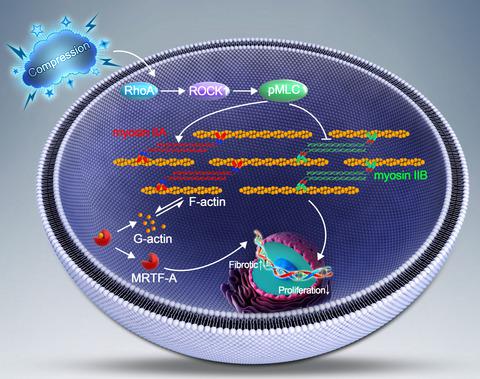当前位置:
X-MOL 学术
›
Cell Prolif.
›
论文详情
Our official English website, www.x-mol.net, welcomes your
feedback! (Note: you will need to create a separate account there.)
The distinct roles of myosin IIA and IIB under compression stress in nucleus pulposus cells
Cell Proliferation ( IF 5.9 ) Pub Date : 2021-01-07 , DOI: 10.1111/cpr.12987 Wencan Ke 1 , Bingjin Wang 1 , Wenbin Hua 1 , Yu Song 1 , Saideng Lu 1 , Rongjin Luo 1 , Gaocai Li 1 , Kun Wang 1 , Zhiwei Liao 1 , Qian Xiang 1 , Shuai Li 1 , Xinghuo Wu 1 , Yukun Zhang 1 , Cao Yang 1
Cell Proliferation ( IF 5.9 ) Pub Date : 2021-01-07 , DOI: 10.1111/cpr.12987 Wencan Ke 1 , Bingjin Wang 1 , Wenbin Hua 1 , Yu Song 1 , Saideng Lu 1 , Rongjin Luo 1 , Gaocai Li 1 , Kun Wang 1 , Zhiwei Liao 1 , Qian Xiang 1 , Shuai Li 1 , Xinghuo Wu 1 , Yukun Zhang 1 , Cao Yang 1
Affiliation

|
OBJECTIVES
Inappropriate or excessive compression applied to intervertebral disc (IVD) contributes substantially to IVD degeneration. The actomyosin system plays a leading role in responding to mechanical stimuli. In the present study, we investigated the roles of myosin II isoforms in the compression stress-induced senescence of nucleus pulposus (NP) cells. MATERIAL AND METHODS
Nucleus pulposus cells were exposed to 1.0 MPa compression for 0, 12, 24 or 36 hours. Immunofluorescence and co-immunoprecipitation analysis were used to measure the interaction of myosin IIA and IIB with actin. Western blot analysis and immunofluorescence staining were used to detect nuclear expression and nuclear localization of MRTF-A. In addition, the expression levels of p-RhoA/RhoA, ROCK1/2 and p-MLC/MLC were measured in human NP cells under compression stress and in degenerative IVD tissues. RESULTS
Compression stress increased the interaction of myosin IIA and actin, while the interaction of myosin IIB and actin was reduced. The actomyosin cytoskeleton remodelling was involved in the compression stress-induced fibrotic phenotype mediated by MRTF-A nuclear translocation and inhibition of proliferation in NP cells. Furthermore, RhoA/ROCK1 pathway activation mediated compression stress-induced human NP cells senescence by regulating the interaction of myosin IIA and IIB with actin. CONCLUSIONS
We for the first time investigated the regulation of actomyosin cytoskeleton in human NP cells under compression stress. It provided new insights into the development of therapy for effectively inhibiting IVD degeneration.
中文翻译:

肌球蛋白IIA和IIB在髓核细胞压缩应力下的不同作用
目的 对椎间盘 (IVD) 施加不适当或过度的压缩会显着导致 IVD 退化。肌动球蛋白系统在响应机械刺激方面起主导作用。在本研究中,我们研究了肌球蛋白 II 亚型在压缩应力诱导的髓核 (NP) 细胞衰老中的作用。材料和方法 将髓核细胞暴露于 1.0 MPa 的压力下 0、12、24 或 36 小时。免疫荧光和免疫共沉淀分析用于测量肌球蛋白 IIA 和 IIB 与肌动蛋白的相互作用。Western印迹分析和免疫荧光染色用于检测MRTF-A的核表达和核定位。此外,p-RhoA/RhoA 的表达水平,ROCK1/2 和 p-MLC/MLC 在压缩应力下的人类 NP 细胞和退行性 IVD 组织中进行测量。结果压缩应力增加了肌球蛋白IIA和肌动蛋白的相互作用,而肌球蛋白IIB和肌动蛋白的相互作用降低。肌动球蛋白细胞骨架重塑参与了由 MRTF-A 核易位介导的压缩应激诱导的纤维化表型和抑制 NP 细胞的增殖。此外,RhoA/ROCK1 通路激活通过调节肌球蛋白 IIA 和 IIB 与肌动蛋白的相互作用来介导压缩应激诱导的人类 NP 细胞衰老。结论我们首次研究了压缩应力下人NP细胞中肌动球蛋白细胞骨架的调节。它为开发有效抑制 IVD 退化的疗法提供了新的见解。
更新日期:2021-01-07
中文翻译:

肌球蛋白IIA和IIB在髓核细胞压缩应力下的不同作用
目的 对椎间盘 (IVD) 施加不适当或过度的压缩会显着导致 IVD 退化。肌动球蛋白系统在响应机械刺激方面起主导作用。在本研究中,我们研究了肌球蛋白 II 亚型在压缩应力诱导的髓核 (NP) 细胞衰老中的作用。材料和方法 将髓核细胞暴露于 1.0 MPa 的压力下 0、12、24 或 36 小时。免疫荧光和免疫共沉淀分析用于测量肌球蛋白 IIA 和 IIB 与肌动蛋白的相互作用。Western印迹分析和免疫荧光染色用于检测MRTF-A的核表达和核定位。此外,p-RhoA/RhoA 的表达水平,ROCK1/2 和 p-MLC/MLC 在压缩应力下的人类 NP 细胞和退行性 IVD 组织中进行测量。结果压缩应力增加了肌球蛋白IIA和肌动蛋白的相互作用,而肌球蛋白IIB和肌动蛋白的相互作用降低。肌动球蛋白细胞骨架重塑参与了由 MRTF-A 核易位介导的压缩应激诱导的纤维化表型和抑制 NP 细胞的增殖。此外,RhoA/ROCK1 通路激活通过调节肌球蛋白 IIA 和 IIB 与肌动蛋白的相互作用来介导压缩应激诱导的人类 NP 细胞衰老。结论我们首次研究了压缩应力下人NP细胞中肌动球蛋白细胞骨架的调节。它为开发有效抑制 IVD 退化的疗法提供了新的见解。











































 京公网安备 11010802027423号
京公网安备 11010802027423号